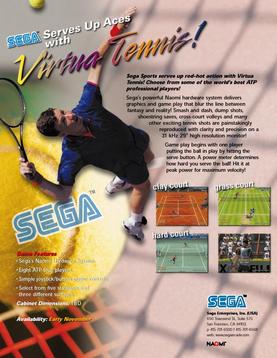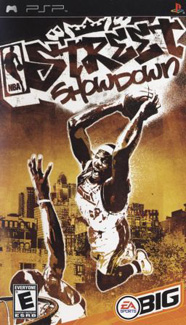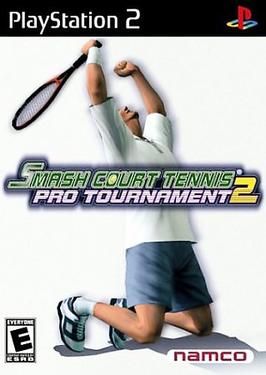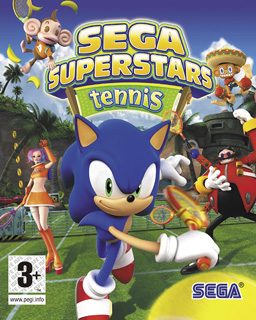
Nights into Dreams is a 1996 action game developed by Sonic Team and published by Sega for the Sega Saturn. The story follows the teenagers Elliot Edwards and Claris Sinclair, who enter Nightopia, a dream world where all dreams take place. With the help of Nights, an exiled "Nightmaren", they begin a journey to stop the evil ruler Wizeman from destroying Nightopia and consequently the real world. Players control Nights flying through Elliot and Claris's dreams to gather enough energy to defeat Wizeman and save Nightopia. The game is presented in 3D and imposes time limits on every level, in which the player must accumulate points to proceed.
A fighting game is a genre of video game that involves combat between two or more characters. Fighting game combat often features mechanics such as blocking, grappling, counter-attacking, and chaining attacks together into "combos". Characters generally engage in battle using hand-to-hand combat—often some form of martial arts. The fighting game genre is related to, but distinct from, the beat 'em up genre, which pits large numbers of computer-controlled enemies against one or more player characters.

Phantasy Star Online is an online role-playing game (RPG) developed by Sonic Team and published by Sega in 2000 for the Dreamcast. It was the first online RPG for game consoles; players adventure with up to three others over the internet to complete quests, collect items and fight enemies in real-time action RPG combat. The story is unrelated to previous games in the Phantasy Star series.

Virtua Tennis, known in Japan as Power Smash, is a 1999 tennis arcade game created by Sega AM3. The player competes through tennis tournaments in an arcade mode. It was ported to the Dreamcast in 2000, and to Windows in 2002. A Game Boy Advance version was also released in 2002, followed by an N-Gage version in 2003. For the home console market, the game was expanded with the introduction of the campaign mode.

Sega Superstars is a party video game developed by Sonic Team for the PlayStation 2. It was published by Sega and released in Europe on October 22, 2004; in North America in November 2, 2004; and in Japan in November 11, 2004. The game features several minigames based on various Sega titles that are controlled using the EyeToy peripheral. Upon release, the game received "average" review scores from critics.

Virtua Tennis 2, known as Tennis 2K2 in North America and Power Smash 2 in Japan, is a sequel to Virtua Tennis that was released for the Sega Dreamcast, Sega NAOMI arcade unit and Sony's PlayStation 2 in 2001–2002. New features included the ability to slice and play as female players such as Monica Seles, Serena Williams, Venus Williams and Lindsay Davenport and the males such as Patrick Rafter, Magnus Norman, Thomas Enqvist and Carlos Moyá and mixed doubles matches. The game was created and produced by Hitmaker, with Acclaim Entertainment publishing it in Europe for the PS2. This was the last Virtua Tennis game to be released for the Dreamcast following its discontinuation.

Virtua Striker is a series of association football sports video games released by Sega for arcades. Originally developed by Sega AM2 from 1994 to 1999, the series moved to Amusement Vision with Virtua Striker 3, but it later moved to Sega Sports Design R&D Dept. with Virtua Striker 4.

Virtua Fighter 2 is a 1994 fighting video game developed by Sega. It is the sequel to Virtua Fighter (1993), and the second game in the Virtua Fighter series. It was created by Sega's Yu Suzuki-headed AM2 and was released for arcades in 1994. Ports were released for the Sega Saturn in 1995 and Microsoft Windows in 1997.

Beach Spikers is a beach volleyball video game released in Japanese arcades in 2001. The game was developed in-house by Sega AM2 and published by Sega. A GameCube port, renamed Beach Spikers: Virtua Beach Volleyball, was released in 2002 for all regions.

NBA Street Showdown is a basketball game for the PlayStation Portable developed by Canadian studio Team Fusion. It was released in 2005, and is the fourth game in the NBA Street series and the first to be portable. It features the gameplay elements of NBA Street Vol. 2, but the presentation of NBA Street V3. The game primarily features minigames, shot blocker and arcade shootout, as well as quick game modes. You can play head to head in all of these through ad hoc mode. To unlock courts, play King of the Courts, where your objective is to defeat a neighborhood street team in games and then in a challenge. Playing the team in shot blocker or playing them in a game without trick points are two challenges. You can play with all current NBA teams and previous teams made up of legendary players.

Rockstar Games Presents Table Tennis is a 2006 table tennis simulation video game developed by Rockstar San Diego and published by Rockstar Games. The game is a realistic simulation of the sport table tennis, with the main objective to make the opponent fail to hit the ball.

Virtua Tennis 3, known in Japan as Sega Professional Tennis: Power Smash 3, is the second arcade game sequel to Sega's tennis game franchise, Virtua Tennis. The arcade version of Virtua Tennis 3 is powered by the PC-based Sega Lindbergh arcade system board. Ports for the PC, Xbox 360, PlayStation Portable and PlayStation 3 consoles are also available with a traditional collection of tennis minigames that the home versions of Virtua Tennis are known for. In 2009, Sega updated and re-created Virtua Tennis 3 in Virtua Tennis 2009.

Top Spin is a 2003 tennis video game developed by PAM Development and Indie Games and published by Microsoft Game Studios for the Xbox, later published by Atari Europe for PC in 2004 and by 2K for the PlayStation 2 in 2005. The game is a simulation tennis game in which players compete in singles and doubles matches, exhibition tournaments, and a career mode in which players develop skills and rise through the ranks of an international league. Featuring an expanded control scheme to its competitors, Top Spin features several innovations including 'risk shots', in which players can execute more difficult serves and shots in addition to flat, top spin, slice and lob swings.
Smash Court Tennis 3 is a tennis video game developed by Bandai Namco Studios for the PlayStation Portable and Xbox 360. The game features world class tennis players such as Roger Federer, Rafael Nadal and Justine Henin. The Xbox 360 version of the game featured updated graphics and new gameplay elements such as the ability to choose player emotions. The Xbox 360 version was delayed in all regions until between late August and early September 2008.

Smash Court Tennis Pro Tournament 2 is a tennis simulation video game developed by Now Production and published by Namco for the PlayStation 2 in 2004. It is the sequel to Smash Court Tennis Pro Tournament.

Sega Superstars Tennis is a sports video game developed by Sumo Digital and published by Sega. It is the second title in the Sega All-Stars series, preceded by Sega Superstars (2005), and crosses over characters, locations, and soundtracks from several Sega franchises, including Sonic the Hedgehog, Space Channel 5, and Super Monkey Ball.

Virtua Tennis 2009, known in Japan as Power Smash: Live Match!, is a 2009 video game developed by Sumo Digital and published by Sega. It is part of the Virtua Tennis series, following Virtua Tennis 3.

Virtua Tennis 4, known in Japan as Power Smash 4, is the third sequel to Sega's tennis game franchise, Virtua Tennis. It was released on PlayStation 3, Xbox 360, Microsoft Windows, Wii and PlayStation Vita. This is the first main series Virtua Tennis game to not have an arcade release before the console releases. An arcade version was also released, which is powered by the PC-based Sega RingEdge arcade system. There are two versions of the cabinet: an upright 4-player cabinet, and a deluxe 4-player cabinet.

Virtua Tennis is a series of tennis simulation video games started in 1999 by Sega AM3. The player competes through tennis tournaments and various arcade modes. While originally released for arcades, all games in the series have been ported to other platforms, including most major consoles.

Virtua Athlete 2K, known as Virtua Athlete 2000 in North America, is a Sega Dreamcast track and field sports game developed by Hitmaker. The arcade game Virtua Athletics, also known in Japan as Virtua Athlete, is based on the Dreamcast version. Virtua Athlete 2K supports up to four local players simultaneously as to compete for the top score through all seven of its events. Virtua Athlete was released on the PlayStation 2 in Japan as part of the DecAthlete Collection with DecAthlete and Winter Heat. The collection is the 15th volume of the Sega Ages 2500 series.


















